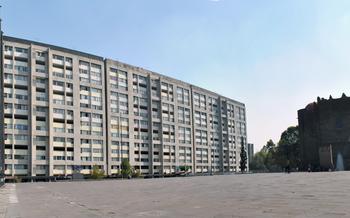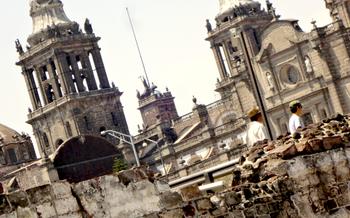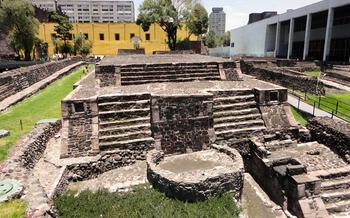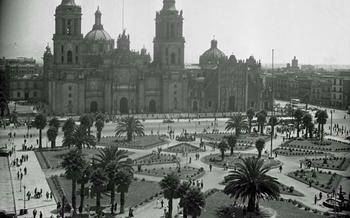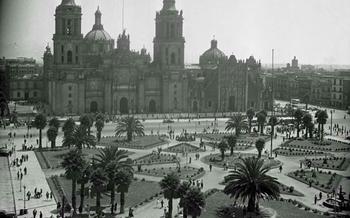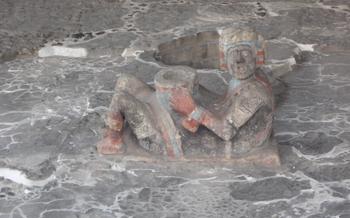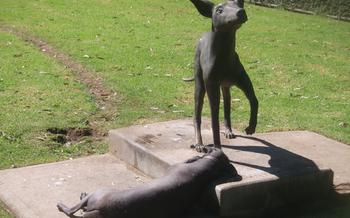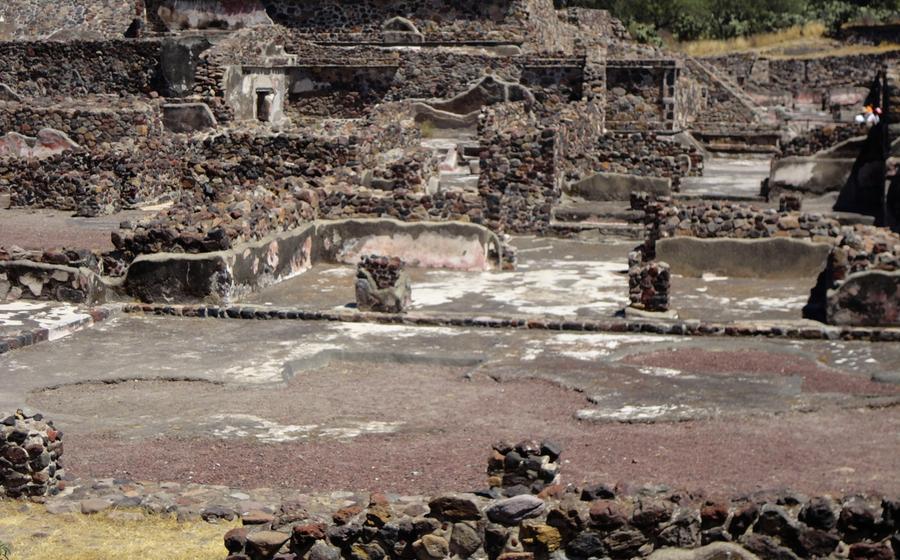
Plaza of the Three Cultures (Tlatelolco)
- Plaza of the Three Cultures: A Historical Overview
- Exploring the Ruins of Tlatelolco
- The Templo Mayor: A Symbol of Aztec Power
- The Pyramid of the Sun: An Astronomical Marvel
- Unraveling the Mysteries of Tlatelolco
- The Cultural Significance of Tlatelolco
- The Museo Nacional de Antropología
- The Church of Santiago Tlatelolco: A Fusion of Cultures
- The Plaza de las Tres Culturas
- Visiting the Plaza of the Three Cultures
- Experiencing the Local Culture
- Transportation to the Plaza of the Three Cultures
- Accessibility and Facilities
- Things to Do Nearby
- Photography and Videography
- Safety and Security
- Insider Tip: Embrace the History
Plaza of the Three Cultures: A Historical Overview
The Plaza of the Three Cultures, located in the heart of Mexico City, is a testament to the rich and complex history of Mexico. It is a place where the pre-Hispanic, colonial, and modern worlds converge, creating a unique and fascinating tapestry of cultures.
The plaza takes its name from the three distinct cultural periods represented within its boundaries: the Aztec, Spanish, and Mexican. The Aztec culture is represented by the ruins of Tlatelolco, a pre-Hispanic city that was once one of the largest and most important in Mesoamerica. The Spanish culture is represented by the Church of Santiago Tlatelolco, which was built on the ruins of the Aztec temple. The Mexican culture is represented by the modern buildings and monuments that surround the plaza, including the Museo Nacional de Antropología.
The Plaza of the Three Cultures is a microcosm of Mexico's history, and it is a place where visitors can learn about the country's past, present, and future.
Exploring the Ruins of Tlatelolco
At the heart of the Plaza of the Three Cultures lies the archaeological zone of Tlatelolco, a testament to the grandeur of the ancient Aztec civilization. Here, visitors can embark on a journey through the past, exploring the ruins of the Templo Mayor, the Pyramid of the Sun, and other structures that once formed the vibrant center of Aztec life.
The Templo Mayor: A Symbol of Aztec Power
The Templo Mayor, meaning "Great Temple," was the most sacred site in the Aztec world. This massive pyramid-shaped structure served as a religious and political center, where the Aztecs performed rituals, made offerings to their gods, and celebrated important events. The temple's intricate carvings and murals depict scenes from Aztec mythology, offering a glimpse into the beliefs and practices of this ancient civilization.
The Pyramid of the Sun: An Astronomical Marvel
Rising majestically above the plaza is the Pyramid of the Sun, the largest pyramid in Teotihuacan and one of the largest in the world. Built with precision and ingenuity, the pyramid aligns perfectly with the cardinal points and is believed to have served as a celestial observatory. Visitors can climb the pyramid's steep steps to reach the top, where they are rewarded with breathtaking views of the surrounding landscape.
Unraveling the Mysteries of Tlatelolco
As visitors wander through the ruins of Tlatelolco, they can't help but be awed by the sheer size and complexity of the ancient city. The intricate carvings, murals, and sculptures that adorn the buildings offer a glimpse into the artistic and cultural achievements of the Aztecs. The ruins of Tlatelolco stand as a testament to the ingenuity and creativity of this remarkable civilization.
The Cultural Significance of Tlatelolco
Tlatelolco held immense cultural significance in pre-Hispanic Mexico. It served as a vibrant trading hub, where merchants from various regions converged to exchange goods, ideas, and technologies. The city's strategic location on the shores of Lake Texcoco facilitated trade routes that spanned the entire Mesoamerican region.
Tlatelolco was also a prominent religious center. The Templo Mayor, a massive pyramid dedicated to the Aztec gods Huitzilopochtli and Tlaloc, stood as a testament to the city's religious importance. Elaborate ceremonies, rituals, and festivals were held at the temple, drawing pilgrims from far and wide.
The Spanish conquest in the 16th century profoundly impacted Tlatelolco. The city was razed to the ground, and its inhabitants were forcibly relocated. The Templo Mayor was destroyed, and the Spanish built a church on its ruins. This act symbolized the imposition of European culture and religion on the indigenous population.
Despite the destruction, Tlatelolco's cultural heritage remained alive. The city's legacy as a trading center and religious hub continued to shape the identity of the Mexican people. The fusion of Aztec, Spanish, and modern Mexican cultures is evident in the architecture, art, and traditions of the Plaza of the Three Cultures, a testament to the enduring spirit of Tlatelolco.
The Museo Nacional de Antropología
The Museo Nacional de Antropologías most comprehensive collections of artifacts from various indigenous civilizations. Among its many awe-inspiring exhibits, the iconic Aztec Calendar Stone stands as a testament to the ingenuity and artistic prowess of the Aztec people. This colossal monolith, intricately carved with calendrical symbols and mythological figures, represents the Aztec worldview and their sophisticated understanding of astronomy.
Beyond the Aztec Calendar Stone, the museum's vast collection encompasses an array of artifacts that shed light on the diverse cultures that have shaped Mexico's rich heritage. From intricate gold jewelry to finely woven textiles, each piece tells a story of the people who created it, their traditions, and their way of life. The museum also boasts an impressive collection of pre-Hispanic sculptures, pottery, and other objects that provide a glimpse into the daily lives and religious practices of ancient Mexican civilizations.
The murals by renowned Mexican artist Diego Rivera are another highlight of the museum. Rivera's vibrant and powerful artworks depict key moments in Mexican history and culture, from the pre-Columbian era to the Mexican Revolution. Through his murals, Rivera sought to create a visual narrative that celebrated Mexico's rich heritage and its struggle for independence and social justice. The Museo Nacional de Antropología is a must-visit destination for anyone interested in exploring the depths of Mexican history and culture. Its vast collection of artifacts and Rivera's iconic murals provide a unique and immersive experience that will leave you with a profound appreciation for Mexico's rich tapestry of traditions and heritage.
The Church of Santiago Tlatelolco: A Fusion of Cultures
The Church of Santiago Tlatelolco stands as a testament to the profound fusion of Spanish and Aztec cultures that shaped Mexico's colonial history. Constructed in the 16th century, the church seamlessly integrates elements of both traditions, reflecting the complex and often contradictory relationship between the two civilizations.
Architecturally, the church exhibits a unique blend of Gothic and indigenous styles. Its facade is adorned with intricate carvings depicting both Christian and Aztec motifs, symbolizing the merging of two distinct worldviews. The interior of the church features a vaulted ceiling supported by massive stone columns, reminiscent of European cathedrals, while the walls are decorated with murals depicting scenes from the life of Christ, rendered in a distinctly Aztec style.
The Church of Santiago Tlatelolco served as a pivotal site in the evangelization of Mexico. Franciscan missionaries used the church as a base for their efforts to convert the native population to Christianity. At the same time, the church became a place of refuge for indigenous communities seeking to preserve their own traditions and identities. This fusion of cultures is evident in the church's design, which incorporates both Spanish and Aztec elements, reflecting the complex and often fraught relationship between the two civilizations.
The Plaza de las Tres Culturas
The Plaza de las Tres Culturas is the heart of Tlatelolco, a vibrant neighborhood in Mexico City. This iconic plaza is a testament to the city's rich and complex history, serving as a microcosm of Mexico's diverse cultural heritage. The plaza's layout and symbolism reflect the fusion of pre-Hispanic, colonial, and modern elements, creating a unique and captivating space.
The plaza's most striking feature is the juxtaposition of the Templo Mayor, a pre-Hispanic pyramid, and the Church of Santiago Tlatelolco, a 16th-century Spanish church. These two structures, standing side by side, symbolize the clash and eventual merging of two distinct cultures. The Templo Mayor, dedicated to the Aztec gods Huitzilopochtli and Tlaloc, was once the religious center of the Aztec Empire. The Church of Santiago Tlatelolco, built on the ruins of an Aztec temple, represents the Spanish conquest and the introduction of Christianity to Mexico.
The plaza also features a number of other significant landmarks, including the Museo Nacional de Antropología, which houses a vast collection of artifacts from various Mexican cultures, and the Memorial to the 1968 Student Movement, which commemorates the tragic events that took place in the plaza during that year.
The Plaza de las Tres Culturas is a powerful reminder of Mexico's rich and often tumultuous history. It is a place where the past and present collide, creating a vibrant and dynamic space that is both awe-inspiring and thought-provoking.
Visiting the Plaza of the Three Cultures
Visiting the Plaza of the Three Cultures is an enriching experience that offers a glimpse into Mexico's rich history and diverse cultures. The plaza is open to the public daily, with extended hours during the summer months. Visitors can purchase tickets at the entrance, which grant access to the site and the Museo Nacional de Antropología.
To make the most of your visit, consider arriving early to avoid the crowds and enjoy the tranquility of the plaza. Comfortable shoes are recommended as you will be doing a lot of walking on uneven surfaces. Remember to bring your camera to capture the stunning views and intricate details of the ruins and monuments.
Guided tours are available for those who prefer a more in-depth exploration of the site. These tours are led by knowledgeable guides who can provide insights into the history, culture, and significance of the Plaza of the Three Cultures. Visitors can choose from various tour options, ranging from general overviews to specialized tours focusing on specific aspects of the plaza.
Whether you choose to explore the plaza independently or with a guided tour, remember to respect the site's historical and cultural significance. Be mindful of your behavior and avoid any actions that may disturb the peace and tranquility of the surroundings. Embrace the opportunity to learn and appreciate the diverse heritage that makes this plaza a unique and captivating destination.
Experiencing the Local Culture
Surrounding the Plaza of the Three Cultures, a vibrant tapestry of local culture awaits exploration. Indulge in the culinary delights of traditional Mexican cuisine at nearby restaurants, where the tantalizing aromas of freshly prepared dishes dance in the air. Sample the sizzling street food, a symphony of flavors and textures, or savor the delectable delicacies in cozy eateries, each a culinary haven.
Venture into the bustling markets, a treasure trove of handicrafts and souvenirs that reflect the rich cultural heritage of Mexico. Engage with the local artisans, who pour their hearts and souls into creating intricate pottery, vibrant textiles, and gleaming silver jewelry. Discover unique pieces that capture the essence of Mexico's diverse artistic traditions, perfect mementos to carry home.
Embrace the warmth and hospitality of the local community, eager to share their stories, customs, and traditions. Engage in lively conversations, learn about their daily lives, and gain a deeper understanding of the vibrant culture that permeates the Plaza of the Three Cultures. Every interaction offers a glimpse into the soul of Mexico, leaving an enduring impression long after your visit.
Transportation to the Plaza of the Three Cultures
To fully immerse yourself in the history and culture of Mexico, a visit to the Plaza of the Three Cultures is a must. Getting to the plaza is relatively straightforward, with various transportation options available.
For those seeking a budget-friendly and eco-friendly option, the metro is an excellent choice. Take Line 3 (the green line) and hop off at the Tlatelolco station. From there, it's just a short walk to the plaza.
If you prefer the convenience of a taxi, you can hail one on the street or arrange for a ride-sharing service like Uber or Didi. Simply input "Plaza de las Tres Culturas" as your destination, and you'll be on your way.
For those arriving by car, there are several parking options available near the plaza. Look for designated parking lots or street parking spaces in the surrounding streets. Be sure to check for any parking restrictions or fees before leaving your vehicle.
To ensure a smooth journey, it's advisable to avoid peak traffic times, especially during the morning and evening rush hours. Plan your visit accordingly to make the most of your time at the Plaza of the Three Cultures.
Accessibility and Facilities
The Plaza of the Three Cultures is committed to providing an inclusive and accessible experience for all visitors. Individuals with disabilities can take advantage of several accessibility features designed to enhance their visit. Wheelchair ramps and elevators ensure that all areas of the plaza are easily accessible, including the museum and the archaeological site. Accessible restrooms are available throughout the complex, and seating areas are strategically placed for those who need to take breaks. Drinking water fountains are also conveniently located for visitors to stay hydrated.
For those who require additional assistance or have specific needs, guided tours are available that cater to visitors with disabilities. These tours are conducted by experienced guides who are knowledgeable about the plaza's history and accessible features. Visitors can inquire about these tours at the information desk or by contacting the plaza's administration in advance.
The Plaza of the Three Cultures strives to create a welcoming and inclusive environment for all visitors, ensuring that everyone can fully experience and appreciate the rich history and cultural significance of this remarkable site.
Things to Do Nearby
While exploring the Plaza of the Three Cultures, take the opportunity to venture into the vibrant surrounding areas. Just a short distance away lies the historic center of Mexico City, a UNESCO World Heritage Site brimming with architectural wonders and cultural treasures. Stroll through the cobblestone streets, marveling at the grandeur of the Metropolitan Cathedral, the National Palace, and the Templo Mayor Museum, which houses fascinating artifacts from the ancient Aztec civilization.
For a leisurely respite, wander along the iconic Paseo de la Reforma, a grand boulevard lined with stately buildings, monuments, and lush parks. Admire the towering Angel of Independence, a symbol of Mexico's struggle for freedom, and soak in the vibrant atmosphere as locals and visitors alike bask in the sunshine. Whether you seek historical exploration, cultural immersion, or simply a chance to relax and people-watch, the surroundings of the Plaza of the Three Cultures offer a wealth of experiences to enrich your visit.
Photography and Videography
Photography and videography are permitted at the Plaza of the Three Cultures, offering an excellent opportunity to capture the beauty and significance of this historic site. However, it is important to adhere to certain guidelines to ensure the preservation of this sacred place and the privacy of other visitors.
When taking photos or videos, always respect the boundaries and avoid disturbing ongoing ceremonies or rituals. Use a telephoto lens or zoom to capture distant shots without intruding on private moments. Refrain from using flash photography, as it can be disruptive and harmful to the delicate artifacts.
It is essential to maintain a respectful demeanor while documenting your visit. Remember that this is a place of cultural and spiritual significance for many people. Ask permission before photographing or filming individuals, particularly those engaged in traditional ceremonies or performances.
By following these guidelines, you can capture the essence of the Plaza of the Three Cultures while respecting its sacred nature and the privacy of its visitors.
Safety and Security
Navigating Mexico City, including the Plaza of the Three Cultures, generally poses no specific safety concerns. However, as with any major urban area, exercising caution and maintaining awareness are prudent. Here are some tips to ensure a safe and enjoyable visit:
- Be mindful of your surroundings and belongings. Keep valuables secure and avoid displaying them openly.
- Stick to well-lit areas, especially at night. If possible, travel with a companion.
- Utilize reputable transportation services, such as official taxis or ride-sharing apps.
- Respect local customs and traditions to avoid any misunderstandings or cultural faux pas.
- If you witness or experience any suspicious activity, promptly report it to the authorities.
- By following these guidelines and staying vigilant, you can fully immerse yourself in the captivating history and cultural treasures of the Plaza of the Three Cultures without compromising your safety.
Insider Tip: Embrace the History
When visiting the Plaza of the Three Cultures, it's essential to go beyond simply admiring the ruins and monuments. Take the time to delve into the rich history and significance of this site, which has witnessed the rise and fall of civilizations and played a pivotal role in shaping Mexico's identity.
To enhance your understanding, consider reading books, watching documentaries, or researching online about the history of Tlatelolco, the Aztec Empire, and the Spanish conquest. These resources will provide context and depth to your visit, allowing you to appreciate the plaza's significance.
Moreover, engage with the local community by interacting with vendors, artisans, and guides. They can share stories, anecdotes, and insights that will bring the history of the plaza to life. By immersing yourself in the local culture and embracing the history of this site, you'll gain a deeper appreciation for its beauty, complexity, and enduring relevance.
